Vietnamese New Year flowers stand as the centerpiece of Tết Nguyên Đán celebrations (Lunar New Year), Vietnam’s most cherished holiday season. These traditional blooms transcend mere decoration, embodying cultural meanings and bringing auspicious energy to homes across the country. From the iconic yellow mai flowers in the South to the delicate pink peach blossoms in the North, each variety carries its own symbolic significance in welcoming the spring festival.
Why Are Tet Flowers Essential in Vietnamese Culture?
How Do Flowers Shape Vietnamese New Year Celebrations?
Vietnamese New Year flowers serve more than just an aesthetic purpose. They are considered symbols of prosperity, good fortune, and happiness for the coming year. Traditionally, families decorate their homes with flowers to usher in positive energy and ensure a fruitful year ahead. Each flower has its own meaning, contributing to the overall atmosphere of renewal and hope that Tết brings.
- Hoa Mai (Yellow Apricot Blossom) is seen as a symbol of wealth and prosperity.
- Hoa Dao (Peach Blossom) represents the vibrant energy and good fortune associated with spring.
- Kumquat trees (Quất) are thought to bring good luck and happiness.
The careful selection and placement of Vietnamese New Year flowers are part of a ritualistic process to ensure that these symbols fulfill their roles in the coming year. Whether it’s arranging peach blossoms in the north or yellow apricot blossoms in the south, the flowers chosen for Tết reflect the values and aspirations of the Vietnamese people.
Discover Related Guides: Happy New Year in Vietnamese: Complete Guide to Tet Greetings (2025)
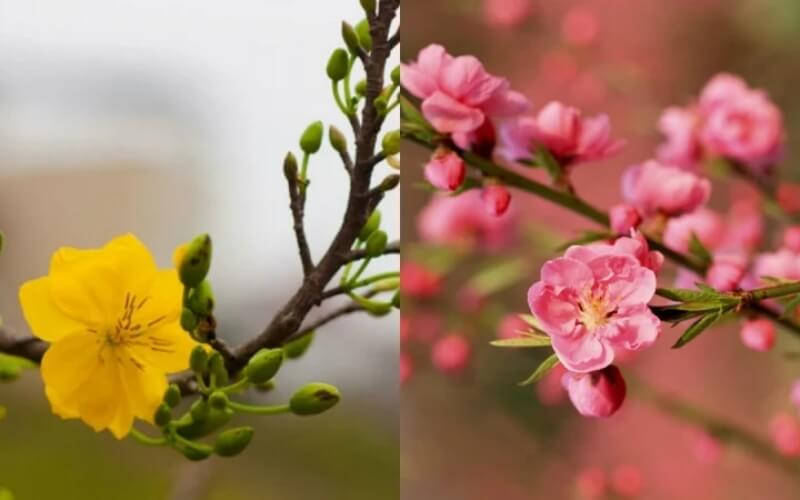
What Makes Tet Flower Traditions Unique in Each Region of Vietnam?
Tết flower customs vary by region, with distinct preferences between the north, central, and south of Vietnam.
- Northern Vietnam favors peach blossoms (hoa đào) for their beauty and association with good fortune. The pink blossoms are traditionally seen as a representation of spring and renewal.
- Southern Vietnam, on the other hand, celebrates with the vibrant hoa mai (yellow apricot blossoms), symbolizing wealth and success. The bright yellow color is associated with prosperity and happiness.
- In the central region, flowers such as chrysanthemums and orchids are popular, often combined with kumquat trees for good luck.
The variation in flowers used reflects the local customs and the different cultural values in each part of the country. Despite these regional differences, flowers remain a universal symbol of well-wishing and celebration during Tết.
Which Flowers and Trees Are Must-Haves for Tet Celebrations?
What Are the 3 Most Important Traditional Tet Plants?
Hoa Dao (Peach Blossom)
When selecting peach blossoms, look for a tree with abundant buds and a healthy trunk. The flowers come in various shades of pink, with deeper pink petals often considered the most auspicious. A common tradition is to select a peach blossom tree with 5 to 7 branches, symbolizing the five elements and seven days of the week, which are thought to bring balance and harmony.
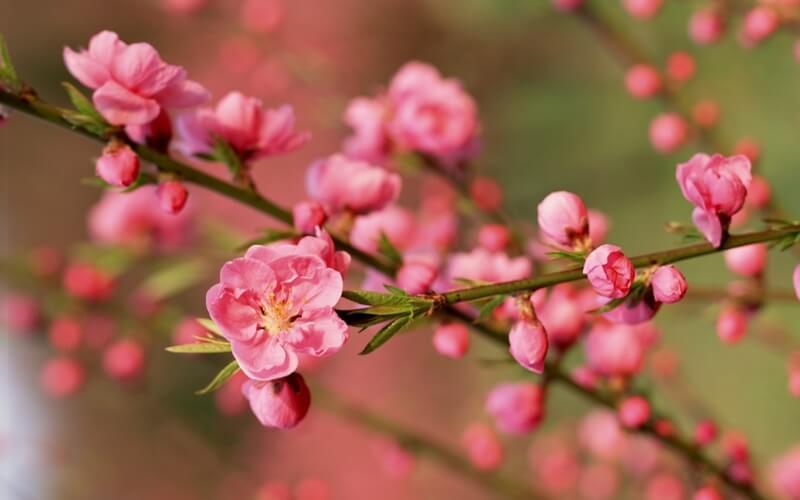
Hoa Mai (Yellow Apricot Blossom)
When choosing a hoa mai tree, ensure that it has bright, fully bloomed flowers and strong, upright branches. The tree should have a rich green foliage to indicate vitality. To care for hoa mai, keep it in a well-lit spot and water it moderately, ensuring it receives enough sunlight without being exposed to harsh conditions.
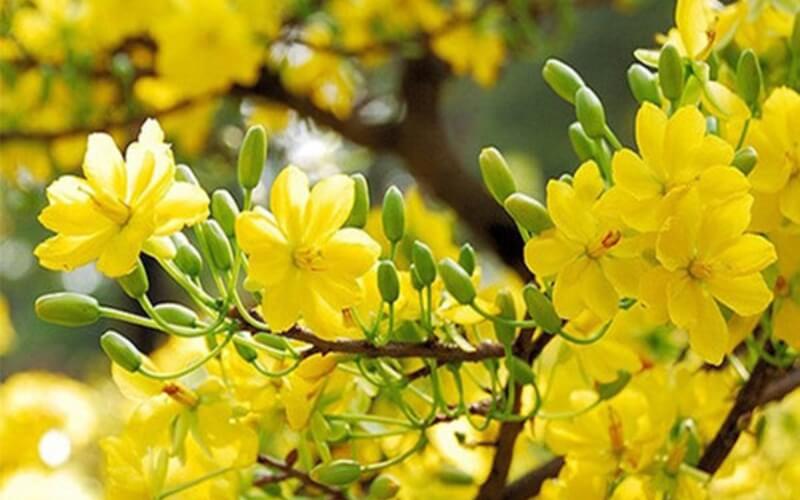
Quat (Kumquat Tree)
The kumquat tree (quất) is another vital Vietnamese New Year flower during Tết. It represents wealth and prosperity due to the small, round fruit that looks like golden coins. Families often place kumquat trees at the entrance of their homes as a welcoming symbol to usher in good luck.
When selecting a kumquat tree, look for one with a healthy green appearance and plenty of ripe fruit. The tree should be well-maintained, with no signs of pests or disease. For maintenance, kumquat trees thrive in direct sunlight and require regular watering, but be sure not to overwater them.
Explore More: Vietnam National Flower: The Sacred Lotus – History & Symbolism
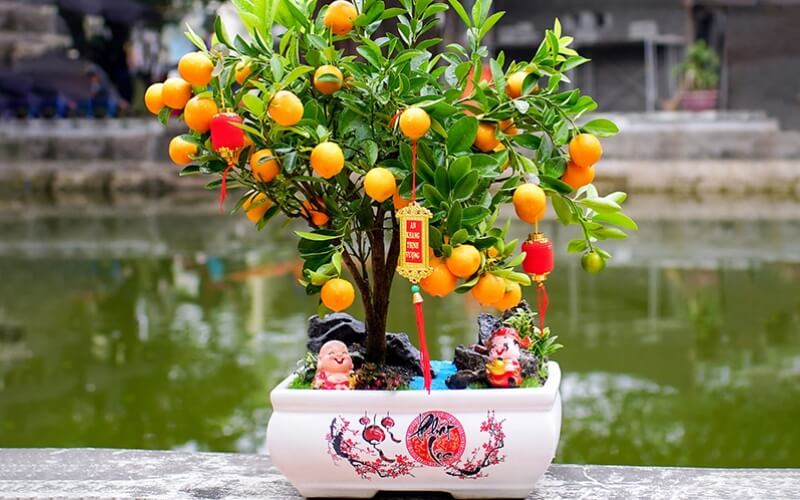
Which Supporting Flowers Complete Your Tet Decoration?
While the main Vietnamese New Year flowers like peach blossoms, apricot blossoms, and kumquat trees are key symbols, there are many other flowers that complement these primary plants.
Chrysanthemum and marigold
Chrysanthemums are believed to represent longevity and health, while marigolds symbolize wealth and prosperity. Both flowers are commonly found in Tết decorations across Vietnam, often used to brighten up homes and create a festive atmosphere.
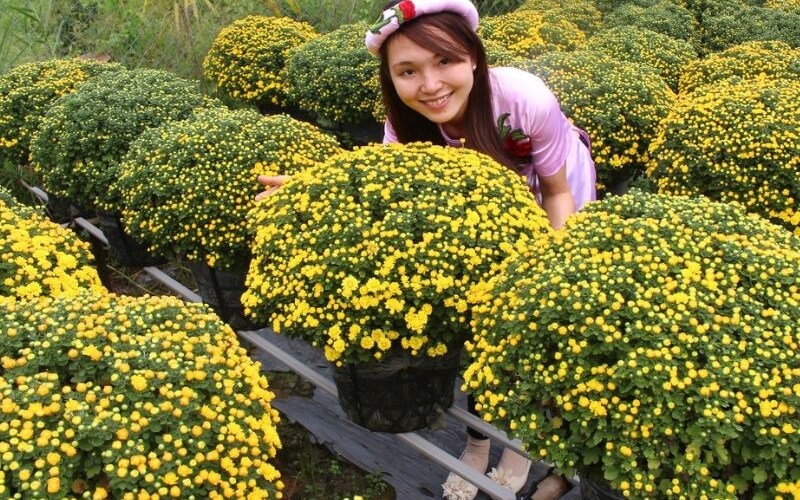
Orchids and lilies
Orchids, known for their elegance and grace, are highly prized during Tết. They symbolize strength, beauty, and resilience. Lilies, on the other hand, are associated with purity and good fortune. Both are used to complement other Vietnamese New Year flowers, creating a harmonious and auspicious environment for the holiday.
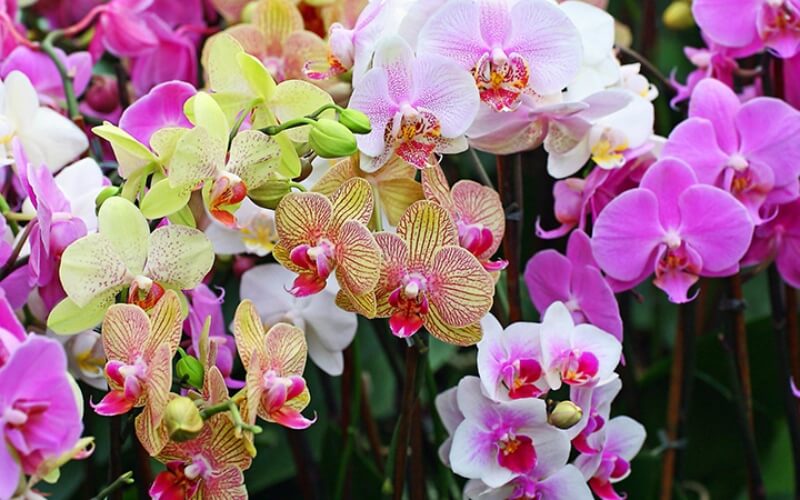
Other traditional blooms and their significance
Other flowers such as roses, tulips, and cockscomb are also used during Tết, each carrying its own symbolism. Roses, often seen as symbols of love and passion, are favored for their vibrant colors and delicate fragrance. Cockscomb, with its bright red hue, is said to bring joy and excitement.
Where Can You Find the Best Tet Flower Markets in Vietnam?
1. Famous Flower markets in Hanoi
In Hanoi, Ngọc Hà and Chợ hoa Quảng Bá are among the most famous flower markets. These bustling markets are filled with a wide array of flowers, from the traditional peach blossoms to exotic orchids. Visitors can experience the vibrant energy of Tết preparations, with Vietnamese New Year flowers being sold and arranged for the upcoming holiday.
2. Danang’s flower markets and traditions
Danang’s flower markets are known for their more relaxed atmosphere, but still offer a diverse selection of Vietnamese New Year flowers. Chợ hoa Tết ở Đà Nẵng showcases regional flowers, with kumquat trees and apricot blossoms being especially popular. The market is a wonderful place to observe local traditions and buy flowers to decorate homes.
3. Ho Chi Minh City’s premier flower markets
In Ho Chi Minh City, Chợ hoa Tết Bến Bình Đông is a must-visit. The market is famous for its extensive range of flowers and plants, especially peach blossoms, apricot blossoms, and kumquat trees. The market draws thousands of visitors each year, offering a perfect blend of tradition and modernity as the city prepares for Tết.
How Can Visitors Make the Most of Their Tet Flower Market Experience?
When Is the Perfect Time to Visit Tet Flower Markets
The best time to visit flower markets is usually around 7-10 days before Tết. This allows enough time for flowers to bloom fully while ensuring you have a wide selection of Vietnamese New Year flowers to choose from.
What Are 3 Expert Tips for Buying Tet Flowers
When purchasing Vietnamese New Year flowers, consider the following tips:
- Check the freshness: Choose flowers with tight buds for a longer blooming period.
- Look for healthy plants: Ensure the plant has vibrant leaves and no signs of pests.
- Select based on region: Consider local preferences when choosing flowers for decoration.
How Do You Keep Tet Plants Fresh Throughout the Holiday?
Caring for Vietnamese New Year flowers involves proper watering and sunlight. Avoid overwatering, as this can cause the flowers to wilt prematurely. For peach blossoms and apricot trees, ensure they are kept in a cool spot to prolong their bloom. If you’re using cut flowers, place them in fresh water daily to keep them vibrant throughout the holiday season.
Questions About Tet Flowers
1. What’s the difference between Northern and Southern Vietnam’s Tet flower preferences?
The primary difference is the choice of flowers. Northern Vietnam prefers peach blossoms (hoa đào), symbolizing vitality and fortune, while Southern Vietnam favors yellow apricot blossoms (hoa mai), which represent prosperity. Both regions also enjoy kumquat trees, but the peach blossom’s dominance in the north and the apricot blossom’s in the south is a key distinction.
2. How long before Tet should I buy flowers and plants to ensure they bloom at the right time?
To ensure Vietnamese New Year flowers bloom at the right time for Tet, it’s best to buy them around 7 to 10 days before the holiday. This allows time for flowers like peach blossoms and apricot blossoms to open up fully. However, be mindful of the specific needs of each plant to ensure they bloom at their peak.
Vietnamese New Year flowers are more than just decorations—they are symbols of hope, prosperity, and renewal. Whether it’s the iconic peach blossoms of the north, the vibrant yellow apricot blossoms of the south, or the various supporting flowers that fill homes with beauty, these plants help usher in the new year with positive energy. Exploring the markets, selecting the best flowers, and caring for them are all part of the special traditions that make Tết a time for family, renewal, and good fortune.






